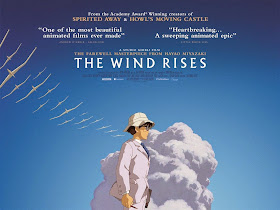I
have mixed feelings about how the film is so heavily emphasised as Miyazaki ’s
swansong. Not because I think he’ll return to the helm, as he did after Mononoke-hime,
but because he’ll still be a dominant force in the studio and even if he only
writes rather than directs, the likes of Porco Rosso 2 are going to be
very close to being ‘Miyazaki films’.
But
aside from that, I am very happy that Miyazaki
got to make this film. It’s the love story to flight that he’s hinted at his
whole career, and it’s clearly in many ways autobiographical despite being
ostensibly about historical figure Horikoshi Jiro. It’s also easily his most
sophisticated and straightforward film as a director, the one time that he has
been more Takahata than Miyazaki ,
more Ozu than Kurosawa, and that is something that I’m very pleased he proved
he could do before the end of his career. Thus, the fantasy here is limited,
more along the lines of magical realism than in the rest of his oeuvre, and the
historical setting is key rather than something distant and whimsical. For the
first time, he writes about the second world war, and how disastrous it was for
Japan – even hinting
at the taboo subject of Japan ’s
conduct in China .
The Bomb looms just off the page, and it is very interesting to remember that
at one point not so long ago Japan
wasn’t leading the world in technology, but scrambling to catch up.
Accordingly, the film has been Miyazaki ’s
most controversial, politically.
It’s
only right that the war enters this picture, though. At the heart of Miyazaki ’s
evaluation of Horikoshi is that the weaponization of planes, while what
provided his funding, stunted his creativity and stood in the way of his genius.
Of course, this is a nice, idealised angle – as critics have pointed out,
leaving out much of the darker side of Mitsubishi’s wartime production – but then,
this is like so many of Miyazaki’s films centred on the changing world and
nostalgia for what is lost. The things that he portrays of his engineering hero
make sense, and the film makes no claims of historical accuracy.
Hiroshiki
from early childhood has a series of visionary, consistent, often prophetic
visions, many of them involving his hero, Giovanni Caproni – who apparently
believes the Japanese boy is appearing in his dreams. Inspired to become
a flight engineer, he studies at Tokyo
University Miyazaki ’s own
thoughts on his home life, and make for some very interesting ambiguity.
Though
the idea is taken from the novel on which the film is loosely based, the film
also has scenes in a sanatorium based on the one in Thomas Mann’s The Magic
Mountain, and its protagonist appears as an eccentric but loveable
foreigner with a huge nose and very broken Japanese – performed by former Ghibli
board of directors member Steve Alpert. There’s similar casting dynamics at
play in the casting of Horikoshi himself – he is played by Evangelion mastermind
and Nausicäa wunderkind Anno Hideaki. This is quite a strange choice –
the things Jiro is most recognisable for here are his glasses and his odd nasal
voice. While Anno’s performance was jarring at first, something about his
unpolished performance actually worked very nicely – it seemed natural and
awkward in an appropriate way.
Technically,
the film was a triumph. Those flight sequences he does so well are of course to
the fore here, and the technical elements are beautifully-done. The characters
look great – and some of the more comic seem more like something out of Ghiblies than the usual films, though never so much so that they seem out-of-place. The
sound effects are often done by voices, like a more refined version of Yadosagashi,
which felt nicely like it had almost been a personal preparation for me. It’s
strange and otherworldly, being a little odd when it comes outside of fantasy
sequences, but I think it works well. The choice of music is also a good touch.
This
isn’t a film for everyone – the audience will likely be a lot smaller than that
for Spirited Away or even Howl’s Moving Castle. Not everyone will
want to sit through it, and it’s much more arthouse. But it is also assured,
moving and quite brilliant. A real gem in an already world-class career.

No comments:
Post a Comment